

George Meikle Kemp. George Meikle Kemp (25 May 1795 – 6 March 1844) was a Scottish carpenter/joiner, draughtsman, and self-taught architect.
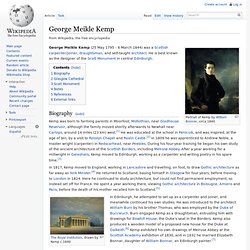
George Meikle Kemp. KEMP, GEORGE MEIKLE.

—This architect, whose great work, the Scott Monument, one of the noblest ornaments of Edinburgh, has secured the admiration of Europe, and the approbation of the highest judges of architectural excellence in every country, was the son of a lowly shepherd, who pursued his occupation on the southern slope of the Pentland Hills. Such a scenery, where nothing but nature predominated, in the form of bare brown mountains and dashing waterfalls, was the least of all adapted to create a perception of the beautiful in art; so that, had not Kemp been born an architect, he would probably have been to the end of his days a shepherd or a mechanic.
But at the age of ten years, having been sent on a message to Roslin, only six miles distant, he then, and for the first time, beheld the creative power of man, in the remains of the ancient castle of Roslin, and above all, in its exquisite gem, the chapel. Overview of George Meikle Kemp. Construction of the Monument. Sadly, George Meikle Kemp died when the monument was only half completed, on the night of 6th March 1844.
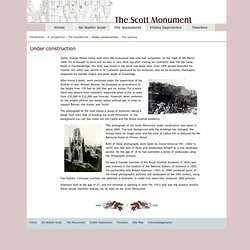
He is thought to have lost his way in very thick fog after visiting his contractor near the old Canal Basin in Fountainbridge. His body was found in the canal one week later. Over 1000 people attended his funeral. His coffin was carried to St Cuthberts graveyard by his workmen, who by all accounts, thoroughly respected his humble origins and great depth of knowledge. Stock photos George Meikle Kemp photographic library. Scott Monument. Scott Monument - Edinburgh Memorial. Scott Monument Edinburgh Memorial to writer Sir Walter Scott – arguably Edinburgh’s most famous & favoured inhabitant.
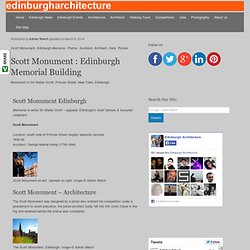
Lost Edinburgh: The Scott Monument. DOMINATING the Edinburgh skyline, the Scott Monument is perhaps the world’s greatest memorial to a writer, with stunning views from its upper reaches lending further credence to that claim. • Visit Lost Edinburgh on their Facebookpage, and follow them on Twitter @lostedinburgh Following the death of world-renowned Scots poet and novelist Sir Walter Scott in September 1832, calls to erect a major public monument in his hometown of Edinburgh were echoed up and down the country.

The competition Fundraising for the monument began in earnest, and by spring 1836 a competition was announced for its design. Scott Monument, Edinburgh 165 Insider Tips, Photos and Reviews. The Scott Monument is a Victorian Gothic monument to Scottish author Sir Walter Scott.

It stands in Princes Street Gardens in Edinburgh, opposite the Jenners department store, near Edinburgh Waverley Railway Station. The tower is 200 feet 6 inches (61.11 m) high, and has a series of viewing decks reached by a series of narrow spiral staircases giving panoramic views of central Edinburgh and its surroundings. The highest viewing deck is reached by a total of 287 steps. (Those who climb the steps can obtain a certificate commemorating the event.) Scott Monument. Scott Monument Princes Street, Edinburgh, UK associated engineer Not known.
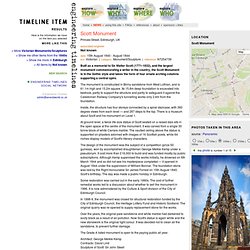
The Scott Monument in Edinburgh : The Gothic Rocket. It is unfortunate that many people around the world may not know who Sir Walter Scott was.
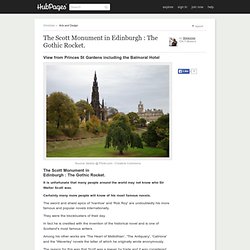
Certainly many more people will know of his most famous novels. The sword and shield epics of 'Ivanhoe' and 'Rob Roy' are undoubtedly his more famous and popular novels internationally. They were the blockbusters of their day. In fact he is credited with the invention of the historical novel and is one of Scotland's most famous writers. Among his other works are 'The Heart of Midlothian', 'The Antiquary', 'Catriona' and the 'Waverley' novels the latter of which he originally wrote anonymously.
The reason for this was that Scott was a lawyer by trade and it was considered unseemly in late 18th century Scottish society for a man of such standing to indulge in mere story-telling. Edinburgh Museums - Edinburgh Museums. The monument was designed by George Meikle Kemp (1795 - 1844) who was inspired by the architecture of Melrose Abbey and Roslin Chapel.

It is over 200 feet (61 metres) high, with 287 steps to four levels from which you can have spectacular views. The foundation stone was laid on August 15th 1840, Scott's birthday, and the inauguration ceremony was held six years later on the same date. Look out for the 64 statues of characters from the books of Sir Walter Scott, the Edinburgh-born writer famous for his historical novels. Learn more of his story and how George Meikle Kemp designed this amazing Gothic structure - a prodigious building feat of its time. Scott Monument - Making of industrial and urban Scotland. After Sir Walter Scott’s death in 1832, the Victorians decided to build a permanent monument to the famous Scots author in Princes Street Gardens in Edinburgh.
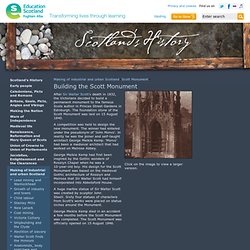
The foundation stone of the Scott Monument was laid on 15 August 1840. A competition was held to design the new monument. The winner had entered under the pseudonym of ‘John Morvo'. In reality he was the joiner and self-taught architect George Meikle Kemp. Scottie's Diary - Scott Monument. BackgroundOn a recent visit to Edinburgh I climbed to the top of the Scott Monument in Princes Street Gardens and took a number of pictures from the viewing platforms. That prompted me to look again not just at the history of the monument and also at the life of Sir Walter, a man who not only wrote great novels and poetry but also focused attention on many of the aspects of Scottish culture and history that we take for granted today. Of course, the monument itself and the views from the top allowed me to create a great video slide show as well. Read on! Sir Walter Scott Born in Edinburgh, the ninth child of a lawyer, Scott contracted polio as a child which left him with a permanent limp.
A prominent figure in Edinburgh society, he entertained famous people like Washington Irving and William Wordsworth. Scott's interest in things Scottish led him to rediscover the Scottish crown and sceptre which had been left, forgotten, in Edinburgh Castle. Biographical Sketch of George Meikle Kemp: Architect of the Scott Monument, Edinburgh : Thomas Bonnar. Fullscreen Author:Thomas BonnarPublisher:W. BlackwoodYear:1892Possible copyright status:NOT_IN_COPYRIGHTLanguage:EnglishDigitizing sponsor:GoogleBook from the collections of:unknown libraryCollection:americana. An expert guide to the life of George Meikle Kemp, architect of the Scott Monument. The Maltings, , Bourne, Lincs. PE10 9PH Tel:+44 (0)1778 391000 • Fax: +44 (0)1778 421706 Last Updated: 10th May 2012 This page (together with the documents referred to on it) tells you the terms on which you may use and access our website whether as a guest or a registered user.
Please read these terms of use and acceptable use policy (Terms) carefully before you start to use the Site. Our Site is a site operated by Warners Group Publications Plc ("We"). We are a public limited company. Access to our Site is permitted on a temporary basis, and we reserve the right to withdraw or amend the service we provide on our Site without notice (see below). From time to time, we may restrict access to some parts of our Site, or our entire Site, to users who have registered with us. When using our Site, you must comply with the provisions of our acceptable use policy as set out in these Terms.
You are responsible for making all arrangements necessary for you to have access to our Site. B) George Meikle Kemp Biography. George Meikle Kemp: architect of the Scott Monument, by Morven Leese. 127p., illustrated. Softcover. £12 (plus £2 UK postage and packing) For orders outside the UK: please contact us for a price including postage and packing. George Meikle Kemp was born in 1795 near Biggar, the son of a shepherd. George Meikle KEMP b. 26 May 1795 Biggar, Lanarkshire, Scotland d. 6 Mar 1844 Edinburgh, Midlothian, Scotland, United Kingdom: KEMP(E) Surname one-name study worldwide - Family History (tree) and Genealogy. The Royal Institution, Edinburgh (now the Royal Scottish Academy) − George Meikle Kemp − K. Site Record for Redscarhead, George Meikle Kemp Memorial Moy HallContribution Contribution.
Redscarhead, George Meikle Kemp Memorial. Redscarhead, George Meikle Kemp Memorial (at Moy Hall) - Peebles - Scottish Borders. If you log in, you can comment on buildings, submit new photos or update photos that you've already submitted. Interested in parks, gardens and open spaces? Check our our new sister site, Parks and Spaces. George Meikle Kemp, Architect of the Scott Monument. George Meikle Kemp, 1795 - 1844. Architect and designer of the Sir Walter Scott Monument Posters & Art Prints by William Bonnar - Magnolia Box. <div class="warn">This page is best when viewed with JavaScript enabled. <span class="how"><a href="index.cfm? Event=information.enableJavascript" rel="nofollow" title="How to enable JavaScript">(how do I enable JavaScript?) </a></span></div> Image Details Title: Your Paintings - George Meikle Kemp (1795–1844), Architect and Designer of the Scott Monument. Portrait - NPG P6(234); Edinburgh Castle: group probably including George Meikle Kemp.
Grave of George Meikle Kemp, St.... (C) kim traynor. DSA Architect Biography Report (March 20, 2014, 2:08 pm)